Related Research Articles
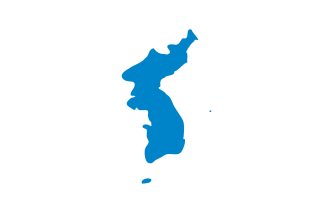
Korea is a peninsular region in East Asia. Since 1945, it has been divided at or near the 38th parallel, now known as the Korean Demilitarized Zone. In 1948, two states declared independence, both claiming sovereignty over all of Korea: South Korea comprising its southern half and North Korea comprising its northern half. The region consists of the Korean Peninsula, Jeju Island, and a number of minor islands near the peninsula. The peninsula is bordered by China (Manchuria) to the north and Russia to the northeast, across the Amnok and Duman rivers. It is separated from Japan to the southeast by the Korea Strait.

North Korea is located in East Asia in the Northern half of Korea, partially on the Korean Peninsula. It borders three countries: China along the Yalu (Amnok) River, Russia along the Tumen River, and South Korea to the south.

Paektu Mountain or Baekdu Mountain (Korean: 백두산) is an active stratovolcano on the Chinese–North Korean border. In China, it is known as Changbai Mountain. At 2,744 m (9,003 ft), it is the tallest mountain in North Korea and Northeast China and the tallest mountain of the Baekdu-daegan and Changbai mountain ranges. The highest peak, called Janggun Peak, belongs to North Korea. The mountain notably has a caldera that contains a large crater lake called Heaven Lake, and is also the source of the Songhua, Tumen, and Yalu rivers. Korean and Manchu people assign a mythical quality to the mountain and its lake, and consider the mountain to be their ancestral homeland.
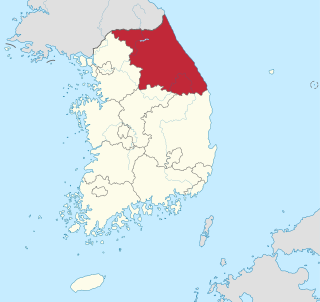
Gangwon State is a Special Self-Governing Province of South Korea and the least densely populated subdivision of the country. Gangwon is one of the two provinces with special self-governing status, the other being Jeju-do. On the east bound by the East Sea, it borders Gyeonggi Province to its west, North Gyeongsang Province and North Chungcheong Province to its south, and the Military Demarcation Line to the north, separating it from North Korea's Kangwŏn Province. Before the division of Korea in 1945 Gangwon and Kangwŏn Provinces formed a single province.
Buddhist temples are an important part of the Korean landscape. Most Korean temples have names ending in -sa, which means "monastery" in Sino-Korean. Many temples participate in the Templestay program, where visitors can experience Buddhist culture and even stay at the temple overnight.

Yeoju is a city in Gyeonggi Province, South Korea. Yeoju was a county but was raised to the status of a city in September 2013. Together with the neighboring city of Icheon, it is known as a major center of contemporary South Korean ceramics, and hosts the World Ceramic Exposition every year. Other local products of note include rice, sweet potatoes, and yellow melons. Yeoju is the birthplace of Korea's last queen, Empress Myeongseong.
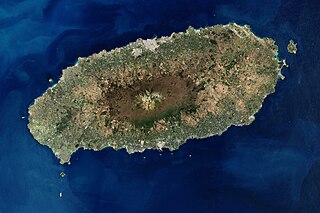
Jeju Island is South Korea's largest island, covering an area of 1,833.2 km2 (707.8 sq mi), which is 1.83 percent of the total area of the country. Alongside outlying islands, it is part of Jeju Province.

Korea comprises the Korean Peninsula and 3,960 nearby islands. The peninsula is located in Northeast Asia, between China and Japan. To the northwest, the Amnok River separates Korea from China and to the northeast, the Duman River separates Korea from China and Russia. The Yellow Sea lies to the west, the East China Sea and Korea Strait to the south, and the Korean East Sea to the east. Notable islands include Jeju Island (Jejudo), Ulleung Island (Ulleungdo), and the Liancourt Rocks.
The Taego Order or Taego-jong is the second largest order in Korean Seon, the Korean branch of Chan Buddhism.
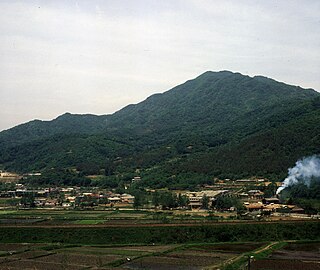
Cheonmasan (Korean: 천마산) is a mountain in Gyeonggi-do, South Korea. It can be found within the boundaries of the city of Namyangju. Cheonmasan has an elevation of 810.2 m (2,658 ft).
Eungbongsan (Korean: 응봉산) is a mountain that sits on the border Samcheok, Gangwon-do and Uljin County, Gyeongsangbuk-do, in South Korea. It has an elevation of 999 m (3,278 ft).
Cheonghwasan (Korean: 청화산) is a mountain between the county of Goesan, North Chungcheong Province and the city of Sangju, North Gyeongsang Province, South Korea. It has an elevation of 984 m (3,228 ft).

Taesŏngsan (Korean: 대성산) is a mountain in Taesong-guyok, Pyongyang, North Korea. It has an elevation of 270 metres (890 ft). One popular visitor attraction on Taesŏngsan is the outdoor ice rink. Others include the Revolutionary Martyrs' Cemetery and the Korea Central Zoo.
Amisan (아미산) is a mountain of Dangjin, Chungcheongnam-do, South Korea. It has an elevation of 349 metres (1,145 ft).

Maisan (Korean: 마이산) is a mountain of Jeollabuk-do, western South Korea. It has an elevation of 686 metres.
Muryongsan is a mountain of Jeollabuk-do, western South Korea. It has an elevation of 1,492 metres (4,895 ft).
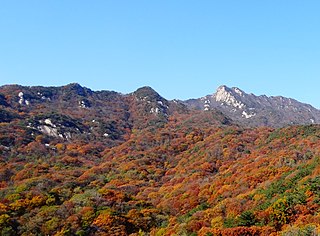
Bohyeonsan or Bohyeon Mountain or Mount Bohyeon is located in the province of Gyeongsangbuk-do, eastern South Korea. Its peak has an elevation of 1,121 metres (3,678 ft), and is near the city of Yeongcheon.

Seonginbong (성인봉) is a mountain located on the South Korean island of Ulleungdo, in North Gyeongsang Province, off the eastern coast of the mainland Korean Peninsula. It is the tallest mountain on the island and has an elevation of 984 metres.
Hwawangsan or Hwawang, is a mountain in Changnyeong County of South Gyeongsang Province, southeastern South Korea. It has an elevation of 757 metres.

The Korean International School of Shenzhen is a South Korean international school that opened in 2005. KIS is located near the Nanshan Mountain, within the Shekou Industrial Zone, Nanshan District. KIS is a private international school with 300 students ranging from kindergarten to high school. However, KIS has only one campus, despite the large number of students. This figure has risen over time and continues to rise.
References
- ↑ An Gyeong-ho (2007). 한국 300 명산 (300 Korean Mountains). Seoul: 깊은솔 (Gipeunsol). ISBN 978-89-89917-21-2.